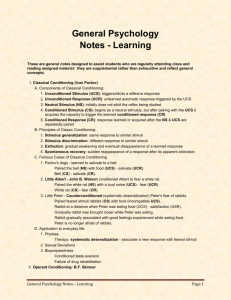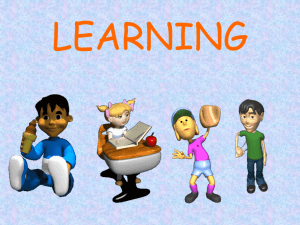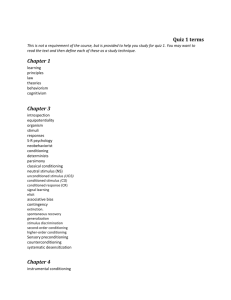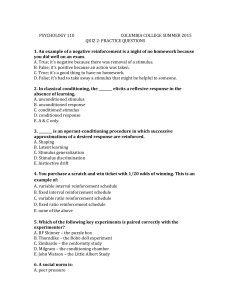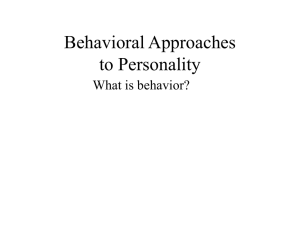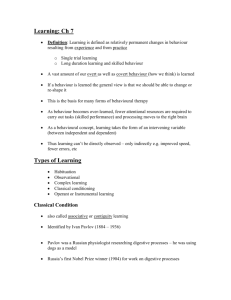Abnormal Psychology
advertisement
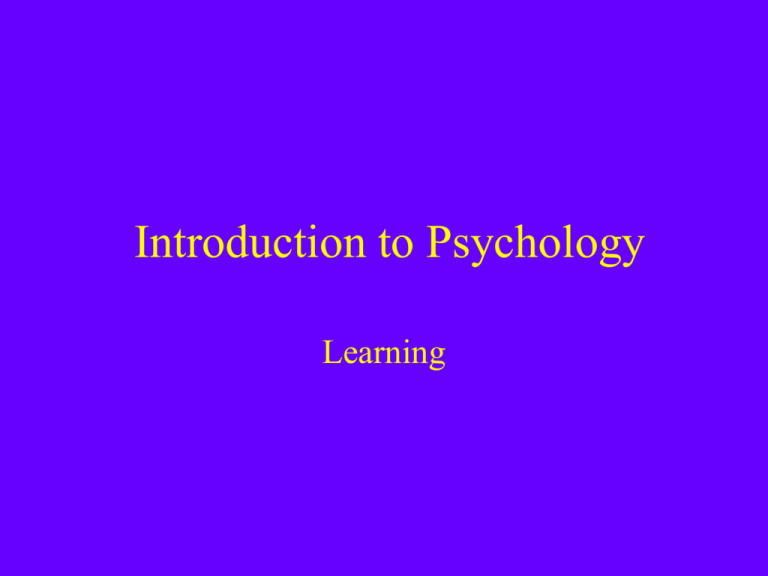
Introduction to Psychology Learning Learning • Learning refers to an enduring change in the way an organism responds based on its experience – Distinct from • Drug effects (caffeine-induced jitters are not learning) • Fatigue or illness • Three assumptions of learning theories – Responses are learned rather than innate – Learning is adaptive – Our experiments can uncover the laws of learning • These laws will apply to animals and to humans Classical Conditioning • The Russian physiologist Pavlov noted that reflexive salivation in dogs could be elicited by stimuli associated with feeding – Reflex: Response that is reliably elicited by a stimulus • Food elicits salivation • Air puff elicits eye blink – Reflexive stimulus and response are unconditioned – Neutral stimulus is referred to as the conditioned stimulus (CS) – CS is paired with the UCS over many trials – Eventually comes to elicit a conditioned response (CR: resembles the UCR) Pavlov’s Experiment Acquisition and Extinction • Acquisition of classical conditioning: – Repeated pairings of CS and UCS • Extinction: Refers to the weakening of conditioning evident when the CS is presented repeatedly without the UCS – Spontaneous recovery: Refers to the reemergence of a previously extinguished CR Stimulus Generalization and Discrimination • Stimulus generalization occurs when an organism that has learned a response to a specific stimulus responds in the same way to new stimuli that are similar to the original stimulus. • Stimulus discrimination occurs when an organism that has learned a response to a specific stimulus does not respond in the same way to new stimuli that are similar to the original stimulus. Classical Conditioning Issues • Temporal order of presentation of CS and UCS is important – Best conditioning: CS precedes UCS (forward) – Worst conditioning: UCS precedes CS (backward) Conditioned Taste Aversion • If a flavor is followed by an illness experience, animals will avoid the flavor in the future CS Taste + CS -----> Flavor UCS ----------> UCR Toxic event Nausea CR Nausea Positive Reinforcement • Reinforcer: An environmental stimulus that occurs after the response and increases the likelihood that the response will occur in the future – Positive reinforcement: Process by which presentation of a stimulus after a response makes the response more likely to occur in the future – Negative reinforcement: Termination of an aversive event makes a behavior more likely to occur in the future Issues in Negative Reinforcement • Negative reinforcement involves a situation in which a response that terminates an aversive stimulus will strengthen that response – Taking an aspirin will reduce the headache and strengthen the behavior of aspirin-taking (sometimes referred to as escape-learning) – Avoidance learning: A response prevents a potentially aversive event from occurring • Child cleans his room to avoid parental nagging Punishment • Punishment decreases the likelihood that a response will occur • Examples of punishing situations – Presentation of an aversive stimulus (Positive) • Parent spanks a child for taking candy... • Owner swats a dog who has chewed her slippers... – Removal of a reward (Negative) • Teenager who stays out past curfew is not allowe d to drive the family car for 2 weeks... • Husband who forgets anniversary sleeps on couch for a week... Difficulties in Punishment • Learner may not understand which operant behavior is being punished • Learner may come to fear the teacher, rather than learn an association between the action and punishment (then avoids the teacher) • Punishment may not undo existing rewards for a behavior • Using punishment when the teacher is angry • Punitive aggression may lead to future aggression Schedules of Reinforcement • Continuous reinforcement: Reinforcer is obtained for every response – Intermittent schedules: Reinforcer is not obtained for every response • Ratio Schedules – Fixed Ratio: Every Nth response – Variable Ratio: The average is every Nth response • Interval Schedules: – Fixed Interval: After the elapse of N minutes – Variable Interval: On average, after N minutes Impact of Schedules of Reinforcement on Behavior Observational Learning • • • • Social Learning Theory (Bandura) Modeling Vicarious learning Acquisition vs. Performance


